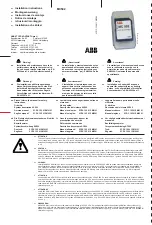
NOTE:
The drive has been formatted before shipment and should not require
reformatting before use.
Consult the reference manual that comes with your computer to locate the
PCMCIA Type III slot. Read additional information from the computer manual
regarding specific instructions on using the PCMCIA slot before installation.
To install the drive, proceed as follows:
NOTE:
If your computer has Card and Socket Services installed, the drive
should work without any further driver installation, and you may skip
to Step 4.
1. Insert the PCMCIA driver disk into the appropriate drive.
2. Change the DOS prompt to the drive where you inserted the PCMCIA
driver disk. Type:
INSTALL <ENTER>
3. Carefully follow the on-screen instructions. Be absolutely sure to read
the on-screen instructions of each installation window before
continuing to the next installation window.
Depending on the choices that you make during the installation
process, new directories may be created on your hard disk, and your
AUTOEXEC.BAT and CONFIG.SYS files may be modified to install
the driver when you start your computer.
4. Hold the PCMCIA card with the 68-pin female PCMCIA connector
facing an available PCMCIA Type III slot.
5. Insert the card into the PCMCIA Type III slot. The keyed guide slots
on the PCMCIA card will not allow incorrect insertion. Insert the card
gently but firmly into the slot until it stops.
6. The drive has been formatted before shipment and should not require
reformatting before use. If you want to format it again, use the
following procedure.
Create a partition on the drive by typing:
“C:\CARDSOFT ATAINIT <Drive Letter>: <Enter>”
where <Drive Letter> is the letter of the new PCMCIA drive (usually D:
or E:).
7. The screen will show:
Fixed Cylinders: = 828 (105 MB), 1010 (130 MB), or 923 (170 MB)
Heads: = 8 (105 MB), 4 (130 MB), or 8 (170 MB)
Physical Sectors/Track: = 31 (105 MB), 63 (130 MB), or 45 (170 MB)
—and—
Hit ENTER to accept and continue or <P> to prompt.
Press “<Enter>.”
Do you wish a compact format?
Type “N” and press “<Enter>.”
8. After running ATAINIT, you must immediately format the drive with
the DOS format utility, using the “/U” option. Type “C:FORMAT
<Drive Letter>/U.” The drive will then be formatted and made ready
for use.






















